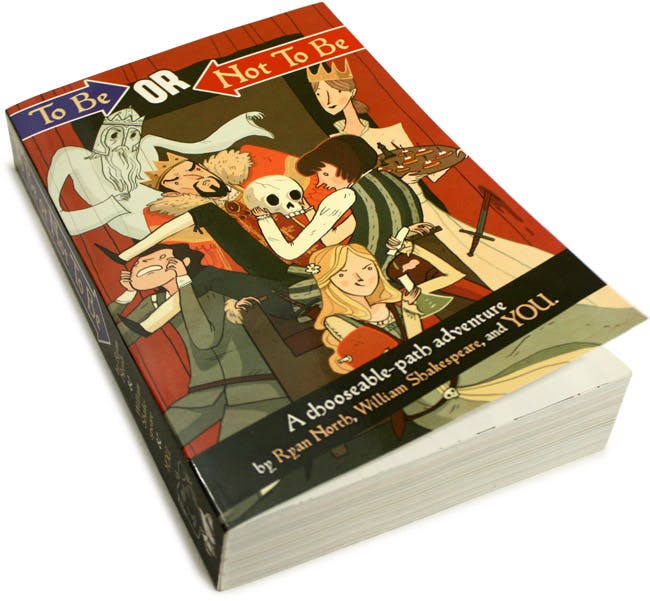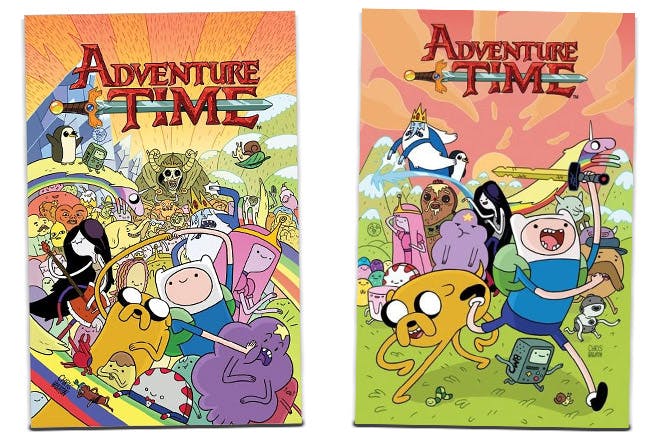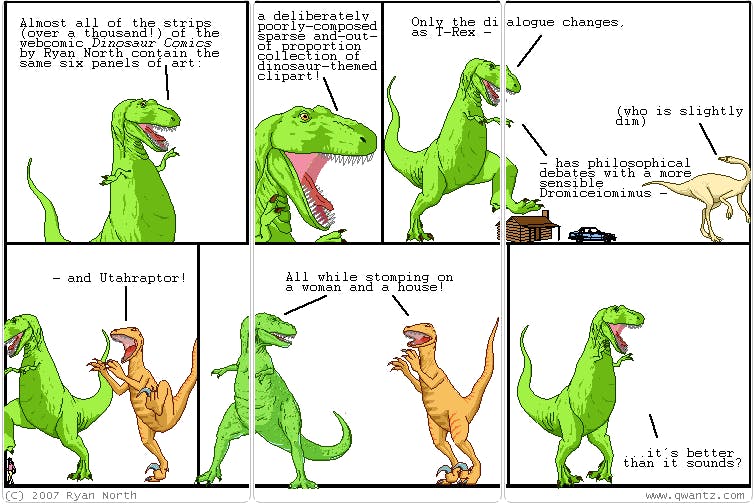When Ryan North started Dinosaur Comics as an undergraduate student in 2003, he couldn’t have predicted that a decade later he’d be not only making a living as an artist, but one of the most successful comics creators on the Web.
More than 70,000 people visit North’s website, qwantz.com, every day, and he told the Daily Dot he’s constantly surprised and amazed that the model he started as an experiment with his first webcomic actually works.
Of course, it’s not just this one comic—starring an aloof Tyrannosaurus who stomps on houses and debates philosophy with more sensible dinosaurs—that supports North. He has his hand in a number of innovative projects. Along with selling merchandise based on his work and developing tools for other webcomics creators, he writes a second webcomic called Galaga and writes the Adventure Time comic book series for BOOM! Studios (which won an Eisner Award and a Harvey Award this year).
While it can sometimes be risky for webcomic creators to become involved in new projects, North’s livelihood has never been in danger. He may have new work and challenges taking up his time, but he’s kept his original comic going strong these last 10 years.
Screengrab via TVtropes
“I’m not stopping a project and then starting something else. I can say to my established readers ‘hey you like this old thing, you might like this new thing I’m working on too!’” North explained. “There are advantages to doing something new like books, where you can let people know what you’ve written and people can say ‘oh Ryan wrote that maybe I’ll check it out’ versus something written by a stranger they might not care about. It’s the advantage of a readership who knows who you are.”
He encourages new webcomic creators to embrace social media and use it to spread the word about their work, not just to readers, but to fellow creators.
The world of webcomics has grown tremendously since North started, but he’s found that growing community more supportive than competitive. According to North, this is because, unlike in the cutthroat business of old-school newspaper cartooning, there’s no need to fight for space on the Web. Recommending someone else’s comic won’t hurt him, it just means people will read more comics.
“The infinite amount of space creates a welcoming atmosphere, which is an advantage to someone new. If their work is awesome they’ll reach people very quickly. It’s ideal. The biggest shift in the last 5 years for webcomics has really been social media. Time was when I put up a comic and was done for the day, maybe I just answered emails a bit. Now people will message me on Twitter about typos right away, which is great. I can see people sharing my comics and talking about them ,which is very gratifying,” North said.
“People also talk about the comics informally and don’t know I’m there, so it’s great, honest feedback. Social media has been a great change. It’s also a great way to disseminate comics and market them.”
Growing social networks and communities also mean more ways for webcomic creators to find support for projects. North had this experience when he started a Kickstarter campaign to fund a choose-your-own-adventure book called To Be or Not to Be. In the first three-and-a-half hours, he reached his funding goal of $20,000. By the end of the 30-day campaign he had raised $580,905, allowing him to create a more elaborate book and change his black and white pages to full color.

Photo via Topatoco
While North recommends Kickstarter for use by other webcomic creators, he warns that those just starting out might want to hold off.
“It’s a lot harder for an author that’s unpublished to say ‘Hey, here’s a new book.’ There’s nothing of theirs to read, so you don’t know what it’s going to be like. Kickstarter is great, but you also have to put your work out there whenever you can so you can build a reputation. So when you do say ‘I got project in need of funding to get it off the ground,’ it’s not random. You’re an author or creator that they hopefully already like,” he said.
Considering North’s success, that’s advice that should give new cartoonists pause. He’s successfully diversified his work into multiple new projects, not just his Kickstarter-funded book. He’s also created online resources for webcomic creators and non-creators alike with comics search engine Oh No Robot, website syndication service RSSpect, and, perhaps most importantly, Project Wonderful.
Project Wonderful is North’s answer to the problem of Web advertising, which North discovered was “kinda terrible” for independent creators. Instead of using the pay-per-click model of traditional ad network, Project Wonderful lets creators auction off ad space on their sites one day at a time. That way, there’s less to manage, and click fraud is impossible.
“Project Wonderful was the result of me not satisfied with the networks out there. I thought, ‘So if we do it, what can we do differently to fix advertising, to make it transparent and fair, and a friendly and fun network that could be really successful in comics?’” North said. “It was fun to do because my undergraduate and graduate degrees were in computer science. I find it satisfying to do this now along with my webcomics and use both halves of my brain. I’ll work on a programming problem then switch to writing, which feels like a break from the other.”
North is a shining example of how webcomic creators are branching out and doing more online and off. For example, he isn’t the only webcomic writer to have a hand in the award-winning Adventure Time series. North said Adventure Time publisher BOOM! Studios has been smart in taking webcomic creators with huge audiences online and hiring them, hoping to bring their audiences along to the series. It’s an example of how there’s more back-and-forth between print and online media than ever before.

Photo via Topatoco.com
“It’s a blurred line. There was a time when we would have web versus print and think about who would win, but really now there are few people online who claim to be a webcartoonist and are against print. When you create a bunch of stuff online it’s easy to put there but some prefer print so you’ll probably gather it together in a book one day,” North said. “Being able to move between the two and not worry about ‘sides’ is terrific and advantageous.”
North will be speaking about all these webcomic issues and more on a panel, “Beyond the Webcomic,” at New York Comic-Con Saturday, October 12. He’ll be joined by fellow webcomic creators Christopher Hastings (The Adventures of Dr. McNinja) and Kate Beaton (Hark! A Vagrant).
“We’ll be talking about making comics, books, using Kickstarter, different ways an online cartoonist can create and disseminate their work, and what the future holds for self-supported artists,” North said. “It’s for webcomic creators but also other people producing their own work. There are so many ways to make a book or comic but most involve doing something online. We’ll talk about how to make things happen.”
Photo via Wikimedia Commons

